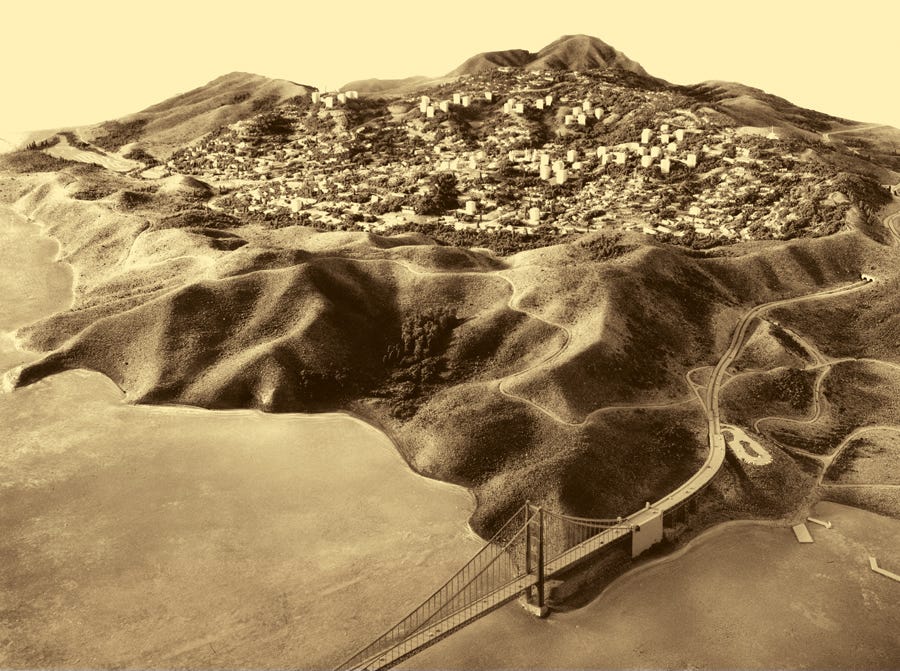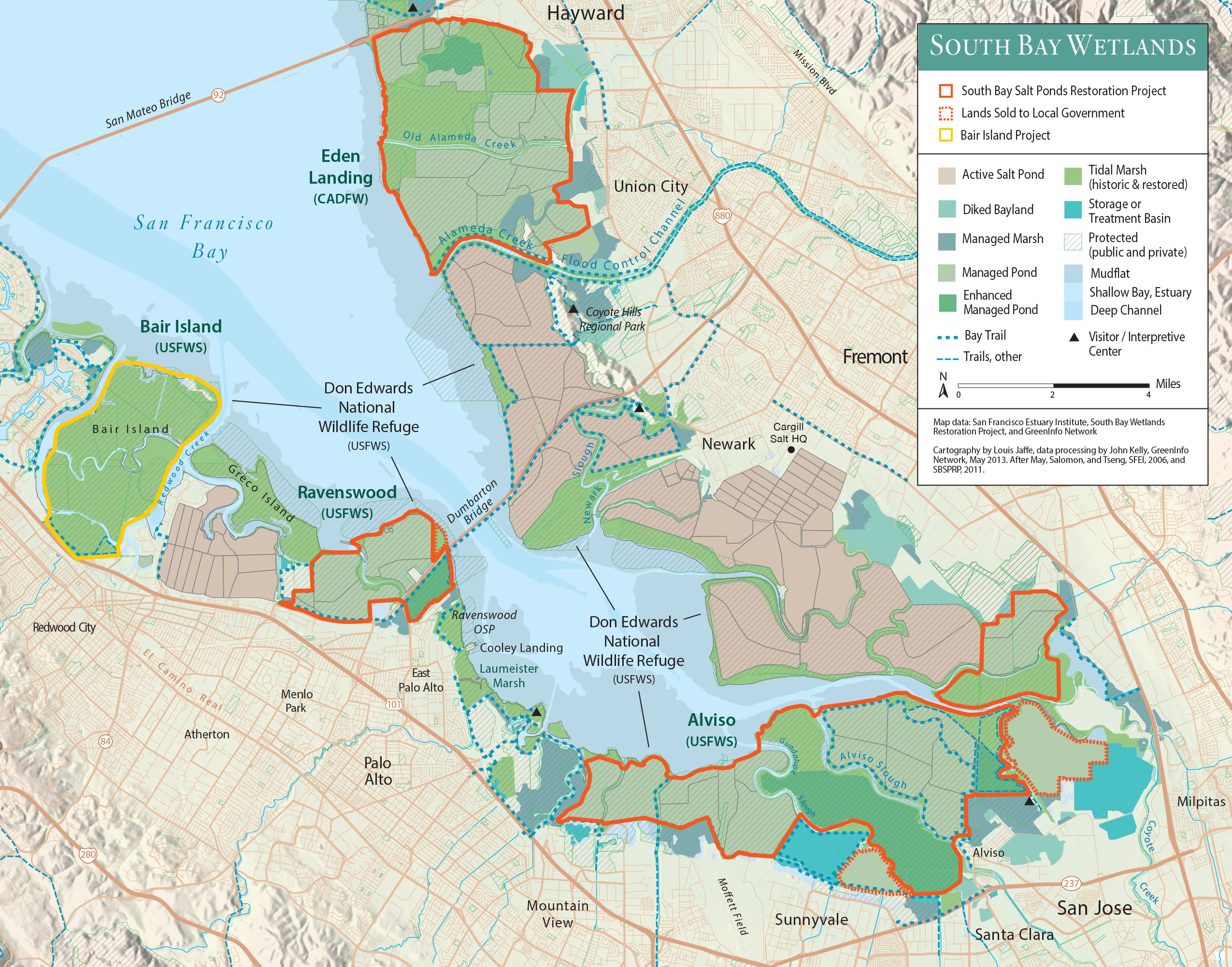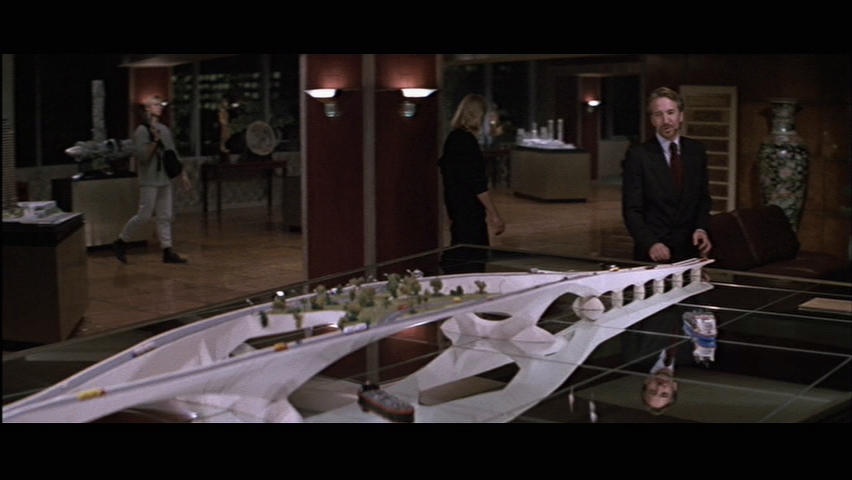kernals12
Banned
Just as I fixed New York, I'm fixing the Bay Area.
November 1965- San Rafael, CA
The Marin County board of supervisors gave its approval to a new development to be located on the Marin Headlands on land previously owned by the military. Known as Marincello, it was designed by developer Thomas Frouge of Bridgeport, CT.

It offered stunning views and extremely quick access to San Francisco. It would house 30,000 people among the hills. Construction started in 1967 and was completed in 1972. This was only the first part of a wave of development that would hit the North Bay region.
Next, a freeway was built from Marincello, going along the western coast up through Bolinas all the way to Reyes Station. Bolinas went from being a sleepy resort town to a bedroom community of 32,000.

Down south, more things were happening. The Westbay Community association dug out a huge chunk of the San Bruno Mountain to fill in 27 square miles of the bay. The leveled off portion became a housing project with 60,000 residents while the filled-in bay became home to 160,000. After the Sylmar Earthquake in 1971, special new earthquake retrofitting became mandatory for new homes.

Between 1982 and 1987, the Leslie Salt Company successively sold off its 44 square miles of Salt Ponds to developers. This provided space for 250,000 people and meant you could throw a rock from Fremont to Sunnyvale.

Marin County also continued its growth, with Ring Mountain being developed in 1983.

Due to seismic risks, it was decided to limit land reclamation, but still, it would be safe to build a viaduct along the edge of the San Pablo Bay, from McNears Beach to Vallejo. This set the stage for extremely rapid growth in Vallejo and the filling in of the wetlands around San Pablo Bay. The population was surging in the North Bay region, it would reach 900,000 in Solano County, 930,000 in Sonoma, and 630,000 in Marin.
The flow of commuters to and from San Francisco was becoming a problem. The Golden Gate Bridge was just bumper to bumper every day.

So, in 1987, a second bridge, the Tiburon Bridge, was opened. It managed to survive the 1989 Loma Prieta earthquake with minor damage.

And as traffic on the Bay Bridge kept rising, a new Southern Crossing was built.

And as the traffic between Marin and San Mateo worsened into the early 90s, San Francisco needed to build new freeways on the West side. The Great Highway, Sunset Boulevard, 19th Avenue, and Park Presidio Boulevard were converted to grade separated highways.

The Bay Area Rapid Transit system, or BART, also was greatly expanded. The line to Concord opened in 1986 and to Novato in 1990. And in the 21st Century, it was expanded to San Jose.
With 11 million people and growing rapidly, the Bay Area is poised for continued success as the tech industry keeps getting bigger. All this comes due to the big ideas of the people in charge in the 60s.
November 1965- San Rafael, CA
The Marin County board of supervisors gave its approval to a new development to be located on the Marin Headlands on land previously owned by the military. Known as Marincello, it was designed by developer Thomas Frouge of Bridgeport, CT.

It offered stunning views and extremely quick access to San Francisco. It would house 30,000 people among the hills. Construction started in 1967 and was completed in 1972. This was only the first part of a wave of development that would hit the North Bay region.
Next, a freeway was built from Marincello, going along the western coast up through Bolinas all the way to Reyes Station. Bolinas went from being a sleepy resort town to a bedroom community of 32,000.
Down south, more things were happening. The Westbay Community association dug out a huge chunk of the San Bruno Mountain to fill in 27 square miles of the bay. The leveled off portion became a housing project with 60,000 residents while the filled-in bay became home to 160,000. After the Sylmar Earthquake in 1971, special new earthquake retrofitting became mandatory for new homes.

Between 1982 and 1987, the Leslie Salt Company successively sold off its 44 square miles of Salt Ponds to developers. This provided space for 250,000 people and meant you could throw a rock from Fremont to Sunnyvale.

Marin County also continued its growth, with Ring Mountain being developed in 1983.
Due to seismic risks, it was decided to limit land reclamation, but still, it would be safe to build a viaduct along the edge of the San Pablo Bay, from McNears Beach to Vallejo. This set the stage for extremely rapid growth in Vallejo and the filling in of the wetlands around San Pablo Bay. The population was surging in the North Bay region, it would reach 900,000 in Solano County, 930,000 in Sonoma, and 630,000 in Marin.
The flow of commuters to and from San Francisco was becoming a problem. The Golden Gate Bridge was just bumper to bumper every day.

So, in 1987, a second bridge, the Tiburon Bridge, was opened. It managed to survive the 1989 Loma Prieta earthquake with minor damage.

And as traffic on the Bay Bridge kept rising, a new Southern Crossing was built.
And as the traffic between Marin and San Mateo worsened into the early 90s, San Francisco needed to build new freeways on the West side. The Great Highway, Sunset Boulevard, 19th Avenue, and Park Presidio Boulevard were converted to grade separated highways.

The Bay Area Rapid Transit system, or BART, also was greatly expanded. The line to Concord opened in 1986 and to Novato in 1990. And in the 21st Century, it was expanded to San Jose.
With 11 million people and growing rapidly, the Bay Area is poised for continued success as the tech industry keeps getting bigger. All this comes due to the big ideas of the people in charge in the 60s.
Last edited:



